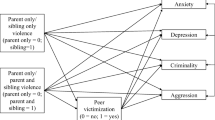Abstract
Over a 2-year period, with assessments every six months, the reciprocity in violent behaviors (verbal and physical) was investigated in a sample of 161 adolescents, who met the criteria for substance or alcohol abuse or dependence, and their caregivers, who participated in a clinical trial for family treatment for adolescent substance abuse. Using observed variables in a structural equation model with panel data, there was very little stability in violent behaviors across time from the perspectives of both the adolescents and caregivers. Evidence for violence reciprocity between adolescent and caregiver was demonstrated toward the end of the study period. The results are discussed in the context of previous literature about adolescent-to-parent violence.

Similar content being viewed by others
References
Beck, A. T., Ward, C., Mendelson, M., Mock, J., & Erlbaugh, J. (1961). An inventory for measuring depression. Archives of General Psychiatry, 4, 53–63. Retrieved from http://archpsyc.jamanetwork.com/issue.aspx?jopurnalid=70&iddueID=12076&direction=P.
Brezina, T. (1999). Teenage violence toward parents as an adaptation to family strain: evidence from a national survey of male adolescents. Youth & Society, 30, 416–444. doi:10.1177/0044118X99030004002.
Browne, K. D., & Hamilton, C. E. (1998). Physical violence between young adults and their parents: Associations with a history of child maltreatment. Journal of Family Violence, 13, 59–79. doi:10.1023/A:1022812816957.
Cottrell, B., & Monk, P. (2004). Adolescent-to-parent abuse: a qualitative overview of common themes. Journal of Family Violence, 25, 1072–1095. doi:10.1177/0192513X03261330.
Herrenkohl, T. I., McMorris, B. J., Catalano, R. F., Abbott, R. D., Hemphill, S. A., & Toumbourou, J. W. (2007). Risk factors for violence and relational aggression in adolescence. Journal of Interpersonal Violence, 22, 386–405. doi:10.1177/0886260506296986.
Kenny, D. A., Kashy, D. A., & Cook, W. L. (2006). Dyadic data analysis. New York: Guilford.
Kim, K. J., Conger, R. D., Lorenz, F. O., & Elder, G. H. (2001). Parent-adolescent reciprocity in negative affect and its relation to early adult social development. Developmental Psycology, 37, 775–790. doi:10.1037/00121649.37.6.775.
Maxwell, B. E. (1992). Hostility, depression, and self-esteem among troubled and homeless adolescents in crisis. Journal of Youth and Adolescence, 21, 139–150. doi:10.1007/BF01537333.
McCloskey, L., & Lichter, E. (2003). The contribution of marital violence to adolescent aggression across different relationships. Jorunal of Interpersonal Violence, 18, 390–412. doi:10.1177/0886260503251179.
Miller, W. R. (1996). Form 90 a structured assessment interview for drinking and related problem behaviors . Project MATCH Monograph Seires, 5.
Moylan, C. A., Herrenkohl, T. I., Sousa, C., Tajima, E. A., Herrenkohl, R. C., & Russo, M. J. (2010). The effects of child abuse and exposure to domestiv violence on adolescent internalizing and externalizing behavior problems. Journal of Family Violence, 25, 53–63. doi:10.1007/s10896-009-9269-9.
Pagani, L., Larocque, D., Vitaro, F., & Tremblay, R. E. (2003). Verbal and physical abuse toward mothers: the role of family configuration, environment and coping strategies. Journal of Youth and Adolescence, 32, 215–222. Retrieved from http://link.springer.com/journal/10964.
Patterson, G. R. (1982). A social learning approach: Coercive family process. Eugene: Castilia.
Rosen, K., Bartle-Haring, S., & Sitth, S. (2001). Using Bowen Theory to enhance understanding of the intergenerational transmission of partner violence. Journal of Family Issues, 22, 124–142.
Slesnick, N., & Tonigan, J. S. (2004). Assessment of alcohol and other drug use by runaway youths: a test-retest study of the from 90. Alcoholism Treatment Quarterly, 22, 21–34. doi:10.1300/J020v22n02_03.
Slesnick, N., Erdem, G., Collins, J., Bantchevska, D., & Katafiasz, H. (2011). Predictors of treatment attendance among adolescent substance abusing runaways: a comparison of family and individual therapy modalities. Journal of Family Therapy, 33, 66–84.
Straus, M. A. (1979). Measuring intarfamily conflict and violence: The Conclit Tactics (CT) Scales. Jrounal of Marriage and the Familiy, 41, 75–88. doi:10.2307/351733.
Swendsen, J. D., & Merikangas, K. R. (2000). The comorbidity of depression and substance use disorders. Clinical Psychology Review, 20, 173–189. doi:10.1016/S0272-7358(99)00026-4.
Thompson, S. J., Zittel-Palamara, K. M., & Maccio, E. M. (2004). Runaway youth utilizing crisis shelter services: Predictors of presenting problems. Child and Youth Care Forum, 33, 387–404. http://dx.doi.org/10.10007/s10566-004-5263-9.
Whitbeck, L. B., Hoyt, D. R., & Ackley, K. A. (1997). Families of homeless and runaway adolescents: a comparison of parent/caretaker and adolescent perspectives on parenting, family violence, and adolescent conduct. Child Abuse & Neglect, 21, 517–528. Retrieved from http://journals.ohiolink.edu/ejc/tiff2pdf.cgi/Whitbeck_Les_B.pdf?issn=01452134&issue=v21i0006&article=517_foharapfvaac.
Yoder, K. A. (1999). Comparing suicide attempters, suicide ideators, and nonsuicidal homeless and runaway adolescents. Suicide: Life-Threatening Behavior, 29, 25–36. doi:10.111/j.1943-278X.1999.tb00760.
Acknowledgments
This work has been supported by NIDA grant (R01 DA016603).
Author information
Authors and Affiliations
Corresponding author
Rights and permissions
About this article
Cite this article
Bartle-Haring, S., Slesnick, N. & Carmona, J. Reciprocity in Adolescent and Caregiver Violence. J Fam Viol 30, 149–159 (2015). https://doi.org/10.1007/s10896-014-9659-5
Published:
Issue Date:
DOI: https://doi.org/10.1007/s10896-014-9659-5




